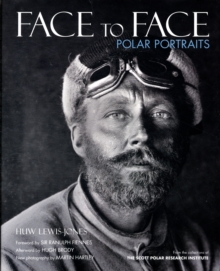A lavish account of pioneering polar photography and modern portraiture, "Face to Face: Polar Portraits" brings together in a single volume both rare, unpublished treasures from the historic collections of the Scott Polar Research Institute (SPRI), University of Cambridge, 'face to face' with cutting-edge modern imagery from expedition photographer Martin Hartley.This unique book by Huw Lewis-Jones is the first to examine the history and role of polar exploration photography, and showcases the very first polar photographs of 1845 through to images from the present day.
It features the first portraits of explorers, some of the earliest photographs of the Inuit, the first polar photographs to appear in a book, and rare images never before published from many of the Heroic-Age Antarctic expeditions.
Almost all the historic imagery - daguerreotypes, magic lantern slides, glass plate negatives and images from private albums - that have been rediscovered during research for this book have never been before the public eye.Set within a 'gallery' of 100 double page-spreads are 50 of the world's finest historic polar portraits from the SPRI collection alternated with 50 modern-day images by Martin Hartley, who has captured men and women of many nations, exploring, working, and living in the Polar Regions today. Each gallery spread, dedicated to a single individual, gives a sense of the isolation and intense personal experience each 'face' has had in living or travelling through the polar wilderness, whether they be one of the world's greatest explorers, or a humble cook.In addition to this remarkable collection is a foreword written by Sir Ranulph Fiennes; a fascinating exploration into 'photography then' - the history of photography and its role in shaping our vision of the polar hero by historian and curator of art at SPRI, Dr Huw Lewis-Jones; a discussion between Dr Lewis-Jones and Martin Hartley about 'photography now', focusing on the essential role that photography plays in modern polar adventuring; and an afterword entitled 'The Boundaries of Light' by the best-selling author Hugh Brody.Does an explorer need to appear frostbitten and adventurous to be seen as heroic, and do we need faces like these to imagine their achievement?Sir John Franklin is the first.
The sun is high. He adjusts his cocked hat, bound with black silk, and gathers up his telescope. He shifts uncomfortably in his chair, positioned on the deck of the stout ship Erebus, as she wallows at her moorings in the London docks.
It is 1845. The photographer, Richard Beard, urges the explorer to stay still for just a moment longer.
He removes the lens cap, he waits, another minute, and then swiftly slots it back in place.
The first polar photographic portrait is secured.Other senior officers of the exploration ships Erebus and Terror had their photographs taken that day, optimistic and ever hopeful.
They appear to us now as if frozen in time. So too they followed Sir John Franklin as he led them in search of a navigable northwest passage, into the maze of islands and straits which forms the Canadian Arctic.'Mr Beard, at Franklin's request, supplied the expedition with a complete photographic apparatus, which was safely stowed aboard the well-stocked ship alongside other technological marvels: portable barrel-organs, tinned meat and soups, scientific equipment, the twenty-horse-power engines loaned from the Greenwich railway, and a library of over twelve hundred volumes.
The camera now formed part of the kit thought essential to travel to the limits of the known world. Weighed down with stores, yet buoyant with Victorian confidence, the expedition sailed from the Thames on 19 May.
The ships were last seen in late July, making their way northward in Baffin Bay, before vanishing without a trace - Huw Lewis-Jones,from the essay 'Photography Then' in "Face to Face".This title is available in both hardback and soft-cover.
It features placement: photography, exploration, travel.
It contains 288 pages in full-colour, including images that have never before been published.
The South Pole was an awful place to be on 18 January 1912.
Captain Scott and his four companions - Wilson, Bowers, Oates, and Evans - had just found that the Norwegian explorer Amundsen had beaten them to the prize one month earlier.
The photograph that the men took that day speaks volumes for their achievement, of course, but there could be no truer record of their total disappointment.
The men look absolutely broken; a photograph on top of everything else seems like a punishment.
They are utterly devastated. A life's ambition has been snatched from their grasp.
Now 800 miles from their base, they dragged themselves northward into the mouth of a raging blizzard. Their photographs and letters home, recovered with their bodies some time later, tell the sad tale of their sacrifice - Sir Ranulph Fiennes.

